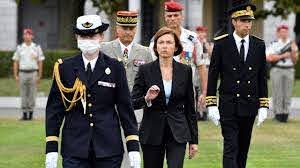Malian and French Authorities Divisions exposed

Announcing the killing of Bah Ag Moussa, described as the military commander of the Group to Support Islam and Muslims (GSIM), French Defence Minister Florence Parly on Friday called it “a major success in the fight against terrorism”.
A former Malian armed forces officer, Ag Moussa – also known as Bamoussa Diarra – later participated in the Tuareg rebellions in the 1990s and early 2000s before turning into a jihadist militant. A close associate of Iyad Ag Ghali – the leader of Mali’s most prominent armed group, Jama’at Nusrat al-Islam wal-Muslimin (JNIM) – Ag Moussa was on the US and UN’s terrorist lists.
Ag Moussa was killed on Tuesday in an operation involving ground troops and helicopters around 100 kilometres from the town of Menaka in eastern Mali, according to the French army.
But his death was announced on Friday, the fifth anniversary of the November 13, 2015 Paris terrorist attacks that killed 130 people. The killing of the major al Qaeda-linked militant has been hailed as a major boost for the thousands-strong French Barkhane force stationed Africa’s Sahel region for over half a decade in a grinding fight against multiple jihadist groups who are often also fighting each other.
It came just over a month after the Malian government freed around 200 jihadist prisoners in a deal to secure the release of former Malian prime minister Soumaila Cissé and French aid worker Sophie Pétronin who were both kidnapped by jihadist groups in Mali.
Over the summer, the impoverished, landlocked West African nation experienced yet another coup amid mounting dissatisfaction over the government’s handling of the security situation.
A transitional government, led by military figures, was later put in place. But tensions between France and Mali have mounted amid major policy differences over how to tackle the former French colony’s endemic jihadist violence. French troops have been engaged in military operations since January 2013, after northern Mali fell to jihadist control.
Amid a rising anti-French sentiment in the country, Malian authorities and community leaders have been advocating dialogue with the militants. But France has made a distinction between engaging with armed groups that have signed peace accords, and “terror groups”.
Can the death of Ag Moussa change the security situation for the Barkhane force? What does this operation reveal about the relations between France and the Malian transitional government? FRANCE 24 posed these questions to Caroline Roussy, a research fellow at the French Institute for International and Strategic Affairs (IRIS).
FRANCE 24: In June, France announced the death of Abdelmalek Droukdel, leader of al Qaeda in the Islamic Maghreb (AQIM). Can the death of Bah Ag Moussa change the security situation in the Sahel?
Caroline Roussy: It is a blow to the GSIM, especially after the images, displayed on social media, of the meeting of the 200 jihadists released in exchange for four hostages, including Frenchwoman Sophie Pétronin and Soumaïla Cissé, a leading Malian political figure.
Those images represented a slap in the face for France, although there was every reason to rejoice over the release of the hostages. The objective of the military operations, that have been multiplying since October 30, seems to be the rallying of troops of the Barkhane force, after the unease caused by the release of these hundreds of jihadists.
A trained soldier, Bah Ag Moussa had strategic insights and knowledge of the terrain. The question is whether he had trained successors and whether others of his caliber could replace him. The death of this leader is therefore significant, but in the medium and long term, I do not believe this changes the situation on the ground because French troops must face an enemy whose contours are increasingly blurred.
Local populations have been joining these armed groups for a number of reasons: opportunism, desperation or the state’s failure to protect them. The central question is: who is the enemy in Mali today? Beyond the increasing complexity of the situation and the domestic dynamics of the threat – which often has little to do with religious motives – the enemy designated since the [January 2020] Pau summit of the G5 Sahel was the Islamic State in the Great Sahara (IS-GS).
But from now on, particular and renewed attention is being paid to the GSIM which, having recovered some 200 men, has received, according to various sources, a ransom of €30 million.
F24: Mali’s transitional Prime Minister, Moctar Ouane, had defended “the need for an offer of dialogue with (jihadist) armed groups” within an “inclusive national dialogue”. This new strike shows that France appears to be favouring a military option…
CR: Yes, it shows deep divisions between Paris and Bamako over whether or not to negotiate with the jihadists. Paris disagrees with the transitional government but also with what the Malians have expressed. In 2017, there was a conference of national accord, and in 2019, an inclusive national dialogue, and each time the Malian population expressed support for dialogue with the jihadists, notably Iyad Ag Ghaly, the head of the GSIM, and Amadou Koufa.
There is a gap that is widening between Paris and Bamako. It is extremely difficult for France to move in this direction in view of the efforts invested since 2013. For the moment, the choice is that of a dynamic of attack on the military field. This raises the question of the future of relations between France and the new Malian government. Will they be able to find common ground or has a line been crossed?
F24: Bah Ag Moussa’s death was announced on November 13, the first anniversary of the deadly Paris attacks. Is there any symbolism in this, or a way to justify the deployment of the Barkhane force?
CR: This is part of the political and governmental discourse. However, there has never been any sign that France would be targeted by attacks from the Sahel. When we speak of Mali, we use categories of analysis that are Western representations: jihadists, terrorists, Islamists… whereas the profile of the enemy is much more complex, nuanced and difficult to grasp. Coming back to the question of November 13, I understand that it may be a question, but I see it as more of a coincidence given the low interest of public opinion in what is happening in the region.



